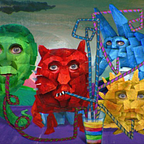It is plain to see that this novel is a book of two halves. It mirrors our own existence, but this might not be so easy to notice, as we are predominantly fixated only on one of the two sides; That is, on the intellect and the realm of the conscious. (how could it be otherwise?)
The book’s chapters alternate, One focussing on the conscious world (Hard-boiled Wonderland), with each of its chapters bearing a ‘three-fold’ title and the other focussing on the unconscious (The End of the World), with only a single theme as the chapter title.
‘From the singular springs the multiplicity.’
The Gatekeeper’s call to rouse the beasts is one long note and three short notes.
These worlds are inter-twined, one informing the other. Communication between these worlds is a difficult affair because they do not ‘speak the same language’.
In Murakami’s novel this communication takes the form of a ‘unicorn skull’.
In ‘The End of the World’, such skulls are the receptacles of ‘dreams’, the language of the unconscious. Whereas In ‘Hard-Boiled Wonderland’, their appearance must necessarily be focussed through the lens of reason and the intellect. It cannot be ‘real’ if it is not reasonable. and hence a story of a lost plateau and the now extinct beast’s skull ending up at a Russian science facility.
Communication is an ongoing theme. The strange old scientist, who turns out to be a biologist, is researching, in particular, the mammalian palate; ‘How the mouth works, and how it gives voice’.
There are also hints towards an evolution of communication. The biologist studies “sound-removal” and claims that sound is “unnecessary to human evolution”. The coarse movement of air, that causes the tiny bones of the ear to vibrate may, in time, be superseded by a more direct, telepathic form.
The narrators in each of the worlds are really only two halves of a whole. Each is a shadow of the other.
In ‘The end of the world’, the shadow that is cut away from the narrator is in fact the ‘Calcutec’, data processor; The other narrator from the companion chapters; A symbol of the ‘mind’, ‘personality’ and ‘reason’.
The death of the shadow is the loss of mind. The end of reason and the severing of the link to ‘Hard-Boiled Wonderland’.
In our current ‘age of the fishes’, (The aeon of Pisces) the worlds are very much separated. The two halves are split apart to form the upper-world and the underworld. (At the entrance to the INKling’s sanctuary is a relief sculpture of two fishes, in a circle, each with the tail of the other in its mouth)
Traditionally the spiritual seeker must descend into the underworld to reunite the lost parts of himself; The ordeal and trial of ‘the dark night of the soul’.
In the early part of Murakami’s novel the narrator takes such a journey; A descent into the symbolic, unconscious realm. The entrance turns out to be in the back of a wardrobe, and the way leads down into the subterranean caverns of the earth. Along the ‘Styx’ and eventually towards the inner sanctum, where all treasure chests are bound to be found; In a cave behind a waterfall, of course!
The strange and disruptive denizens of this realm are the ‘INKlings’, literally hints or ideas originating in the mind.
At the front of the novel is a map of ‘The End of the World’. In the story the narrator is asked to make such a map by his shadow. The unconscious is of course, the unmapped. To map it is to make it conscious.
The map turns out to resemble the human brain with it’s two hemispheres. This mirrors the data scrambling process the Calcutec performs as he shifts data between the hemispheres of his brain; Between the conscious and unconscious.
The watchtower is positioned like an optical nerve, overlooking the ‘West Gate’; The place where the outside meets the inside. The other striking landmark is the ‘clock tower’, an imposing, seemingly inaccessible structure positioned to mirror a unicorn’s horn.
The Librarian in ‘The End of the World’ is also a part of the narrators ‘self’. He must make a decision, whether to try and escape with his shadow (mind), or allow the shadow to die and stay with the Librarian (his soul)
I take a sip of coffee and assure myself that my conclsion is not wrong. To be sure, either way i will be losing a part of me.
The librarian is an ‘anima’ figure (the unconscious feminine side of a man)
A yellow powder of light diffuses in a halo behind her, veiling her silhouette. she wears a blue coat.
I look at her and say nothing. Her face comes almost as a reminiscence. What about her touches me? I can feel some deep layer of my consciousness lifting towards the surface. What can it mean? The secret lies in distant darkness.
Her face bears a fatal connection to something in me. But it is too faint. I shut my eyes and search blindly. Silence falls over me like a fine dust.
The ending, as can be expected, is unclear and presents more questions than answers. The shadow (mind) returns to its native ‘Wonderland’ to continue living as a Calcutec. This is the start of ‘a spiritual journey’ though. A light has been shone on the self and the soul; And all parties have been changed. The separated parts have managed to draw closer.
What was unconscious now has a rudimentary map.
